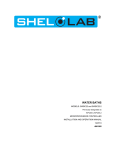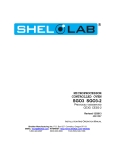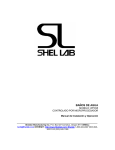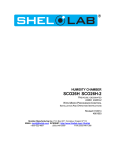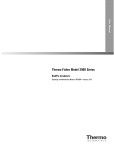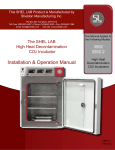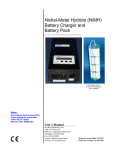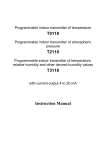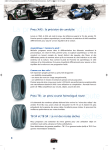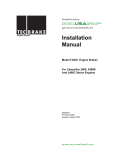Download User Manual - Spectra Services
Transcript
WATER BATHS SWB30 SWB30-2 Previously Designated as WPC95 & WPC95-2 MICROPROCESSOR CONTROLLED INSTALLATION AND OPERATION MANUAL 4861564 Revised December 20, 2013 These units are TUV CUE listed as water baths for professional, industrial or educational use where the preparation or testing of materials is done at approximately atmospheric pressure and no flammable, volatile or combustible materials are being heated. These units have been tested to the following requirements: CAN/CSA C22.2 No. 61010-1:2012 CAN/CSA C22.2 No. 61010-2-010 + R:2009 UL 61010A-2-010:2002 UL 61010-1:2012 EN 61010-1:2010 EN 61010-2-010:2003 IEC 61010-1:2010 IEC 61010-2-010:2003 Sheldon Manufacturing Inc. P.O. Box 627 Cornelius, Oregon 97113 EMAIL: [email protected] INTERNET: http://www.Shellab.com PHONE: 1-800-322-4897 (503) 640-3000 FAX: (503) 640-1366 2 Microprocessor Control Water Baths TABLE OF CONTENTS INTRODUCTION........................................................................................................................................... 4 General Safety Considerations ........................................................................................................ 4 RECEIVING YOUR UNIT .............................................................................................................................. 5 Inspection Guidelines ....................................................................................................................... 5 Returning Shipment.......................................................................................................................... 5 Recording Data Plate Information .................................................................................................... 5 GRAPHIC SYMBOLS .................................................................................................................................... 6 INSTALLATION ............................................................................................................................................. 7 Environmental Conditions ................................................................................................................ 7 Power Source ................................................................................................................................... 7 Location ............................................................................................................................................ 7 Lifting and Handling.......................................................................................................................... 7 Cleaning and Decontamination ........................................................................................................ 7 CONTROLS OVERVIEW .............................................................................................................................. 8 Power Switch .................................................................................................................................... 8 Main Temperature Controller ........................................................................................................... 8 Fuses................................................................................................................................................ 8 Over Temperature Limit Thermostat (OTL) ..................................................................................... 8 Heating Activated ............................................................................................................................. 8 Over Temperature Activated Light ................................................................................................... 8 OPERATION ................................................................................................................................................. 9 Turning On the Unit .......................................................................................................................... 9 Setting Main Temperature Control ................................................................................................... 9 Calibrating the Main Temperature Control ....................................................................................... 9 Setting the Over Temperature Limit Thermostat............................................................................ 10 Bath Cover Assembly ..................................................................................................................... 11 MAINTENANCE .......................................................................................................................................... 12 Cleaning ......................................................................................................................................... 12 Heating and Water Level................................................................................................................ 12 Test-tube Racks ............................................................................................................................. 12 TROUBLESHOOTING ................................................................................................................................ 13 Service ........................................................................................................................................... 14 PARTS LIST ................................................................................................................................................ 15 UNIT SPECIFICATIONS ............................................................................................................................. 16 SCHEMATICS ............................................................................................................................................. 17 Microprocessor Control Water Baths 3 Section INTRODUCTION 1 Thank you for choosing a general purpose water bath. These units are not intended for use at hazardous or household locations. Before you use the unit, read this entire manual carefully to understand how to install, operate, and maintain the unit in a safe manner. Your satisfaction with the unit will be maximized as you read about its safety and operational features. Keep this manual on-hand so it can be used by all operators of the unit. Be sure all operators of the unit are given appropriate training before you put the unit in service. Note: Use the unit only in the way described in this manual. Failure to follow the guidelines and instructions in this manual may be dangerous and illegal. General Safety Considerations Your water bath and its recommended accessories have been designed and tested to meet strict safety requirements. For continued safe operation of your water bath, always follow basic safety precautions including: Read this entire manual before using the water bath. Be sure you follow any city, county, or other ordinances in your area regarding the use of this unit. Use only approved accessories. Do not modify system components. Any alterations or modifications to your water bath may be dangerous and will void your warranty. Always plug the unit’s power cord into a grounded electrical outlet that conforms to national and local electrical codes. If the unit is not grounded, parts such as knobs and controls may conduct electricity and cause serious injury. Do not connect the unit to a power source of any other voltage or frequency beyond the range stated on the power rating overlay at the rear of the unit. Do not modify the power cord provided with the unit. If the plug does not fit an outlet, have a proper outlet installed by a qualified electrician. Avoid damaging the power cord. Do not bend it excessively, step on it, place heavy objects on it. A damaged cord can easily become a shock or fire hazard. Never use a power cord after it has become damaged. Do not position equipment in a manner that prohibits access to power cord. Do not attempt to move the unit while in operation or before the unit has been allowed to cool. Microprocessor Control Water Baths 4 Section RECEIVING YOUR UNIT 2 Before leaving our factory, all units are packaged in high quality shipping materials designed to provide protection from transportation related damage. Once a unit leaves our factory, safe delivery becomes the responsibility of the carrier who is liable for loss or damage to your unit. Damage sustained during transit is not covered under your unit warranty. When you receive your unit, inspect it for concealed loss or damage to its interior and exterior. Should you find any damage to the unit, follow the carrier’s procedure for claiming damage or loss. Inspection Guidelines Carefully inspect the shipping carton for damage. If the carton is damaged, report the damage to the carrier service that delivered the unit. If the carton is not damaged, open the carton and remove its contents. Verify that all of the following equipment is included in the crate: One (1) water bath unit One (1) bath cover One (1) magnetic thermometer clip One (1) power cord Carefully check all packaging before discarding. Save the shipping carton until you are sure everything is in order. Returning Shipment If you must return the unit for any reason, first contact your service representative for authorization. You will be asked to provide the data plate information. See Recording Data Plate Information. Recording Data Plate Information Once you have determined the unit is free from damage, locate the data plate at the back of the unit. The data plate indicates your unit’s model number and serial number. Record this information below for future reference. Table 1. Data Plate Information Model Number Serial Number Part Number Voltage 5 Microprocessor Control Water Baths Section GRAPHIC SYMBOLS 3 Your unit is provided with a display of graphic symbols that should help in identifying user adjustable components. Table 2. Symbols Symbol Identification Indicates that you should consult your operator’s manual for further instructions. Indique que l'opérateur doit consulter le manuel d'utilisation pour y trouver les instructions complémentaires. Indicates “Temperature” Repère "température" Indicates “Over Temperature Protection” Signale un "dépassement de température" Indicates “AC Power” Repère "secteur AC" I Indicates the power is “ON” O Indicates the power is “OFF” Repère de la position "MARCHE" de l'interrupteur d'alimentation Repère de la position "ARRÊT" de l'interrupteur d'alimentation Indicates “Protective Earthground” Repère de la "terre de protection" Indicates “Up” and “Down” respectively Touches de déplacements respectifs vers le "HAUT" et le "BAS" Indicates “Manually Adjustable” Signale un élément "réglable manuellement" Indicates “Potential Shock Hazard” behind partition Signale un "risque potentiel d'électrocution" au-delà de la cloison. Indicates “Hot Surface” Signale une “surface à haute température” Indicates “Unit should be recycled” (Not disposed of in land-fill). Indique “l’appareil doit être recyclé“ (Ne pas jeter dans une décharge) Microprocessor Control Water Baths 6 Section INSTALLATION 4 Your satisfaction and safety require a complete understanding of this unit. Read the instructions thoroughly and be sure all operators are given adequate training before attempting to put the unit in service. This equipment must be used only for its intended application; any alterations or modifications will void your warranty. Local city, county, or other ordinances may govern the use of this equipment. If you have any questions about local requirements, please contact the appropriate local agency. The end user may perform installation. Environmental Conditions Under normal circumstances these units are intended for use indoors, at room temperatures between 18 and 40C, at no greater than 80% relative Humidity (at 25C) and with a supply voltage that does not vary by more than 10% from the data plate rating. This equipment should not be operated at an altitude exceeding 2000 meters. Installation category is II, pollution degree 2. Customer service should be contacted for operating conditions outside of these limits. Power Source Check the data plate for voltage, cycle, and ampere requirements. If matched to your power source, plug the power cord into a grounded outlet. Voltage should not vary more than ± 10% from the data plate rating. These units are intended for 50/60-HZ application. A separate circuit is recommended to prevent damage to the unit due to overloading or circuit failure. Location In selecting a location, consider all conditions that might affect performance, such as heat from radiators, ovens, autoclaves, etc. Avoid direct sun, fast-moving air currents, heating and cooling ducts, and high traffic areas. Allow a minimum of 10 cm between the unit and any walls or partitions that might obstruct free airflow. Lifting and Handling These units are heavy and care should be taken to use appropriate lifting devices that are sufficiently rated for these loads. Units should only be lifted from their bottom surfaces. Handles and knobs are not adequate for lifting or stabilization. The unit should be completely restrained from tipping during lifting or transport. All moving parts such as trays or covers should be removed during transfer to prevent shifting and damage. Cleaning and Decontamination In the event hazardous material is spilled onto or into the equipment appropriate decontamination must be carried out. If there is any doubt about the compatibility of decontamination or cleaning agents with parts of the equipment or with material contained, please contact the manufacturer. Units are cleaned at the factory, but not sterilized. Remove any racks if assembled and clean the bath with a disinfectant that is suitable for your application. See MAINTENANCE for cleaning instructions and precautions. 7 Microprocessor Control Water Baths Section CONTROLS OVERVIEW 5 This section provides an overview of the panel controls. See Figure 1 for an illustration of the panel controls. Figure 1. Control Panel Power Switch The Green I/O (On/Off) power switch, located in the top right hand corner of the control panel, controls all power to the unit. It must be in the I position to be ON and illuminated before any systems are operational. The on/off switch must remain easily accessible at all times. Main Temperature Controller This control is marked SET TEMPERATURE and consists of the digital display and UP and DOWN arrow pads for inputting set point temperatures and calibration. Fuses The fuses are located at the back of the unit within the fuse holders. The fuses act as a circuit breaker and will cut off power to the unit if there is an electrical surge or malfunction. The fuses must be in place for the unit to operate. Please contact customer service for more information. Over Temperature Limit Thermostat (OTL) This controller is marked “Set Over Temperature” and is completely independent of the Temperature Controller. The OTL guards against any failure of the Temperature Controller that would allow the temperature to rise past set point. If the temperature rises to the OTL set point, the OTL takes control of the heating element and allows continued use of the water bath until the problem can be resolved or service can be arranged. The OTL is manually adjusted with a screwdriver or coin so accidental adjustment cannot occur. Heating Activated This light is ON when the Temperature Controller has activated the heating element to reach and maintain set point. Over Temperature Activated Light This light is ON when the Over Temperature Safety Thermostat has been activated. Under normal operating conditions this light should never be on. Microprocessor Control Water Baths 8 Section OPERATION Warning: 6 These baths are not intended for use as acid baths. Use as an acid bath will cause severe damage to bath components and void your warranty. Do not use deionized water, tap water, or chemicals. USE DISTILLED WATER ONLY. Attention : Ces bains d'eau ne sont pas conçus pour les acides. Utiliser un tel bain comme bain d'acide l'endommagera gravement et annulera la garantie. Ne pas utiliser d'eau désionisée, d'eau du robinet ni de produits chimiques. UTILISER EXCLUSIVEMENT DE L'EAU DISTILLÉE. Turning On the Unit To turn on the unit, perform the following steps: 1. Check power supply against unit serial plate; they must match. 2. Plug service cord into the electrical outlet. If supplied with a detachable cordset, plug the female end into the unit inlet and the male plug into the power supply. Verify that units requiring a fuse have the fuse installed in the power inlet. 3. Fill bath to your required depth with DISTILLED WATER. DO NOT USE TAP WATER, DEIONIZED WATER, OR CHEMICALS. Normal depth is 5 ½ inches (14 cm), but depth must be at least 2 inches (5 cm) over the bottom of the rack. Check water level frequently, add water to appropriate levels if needed. At higher operating temperatures, or under circumstances where a cover cannot be used, it will be necessary to check the water level more frequently. 4. Push the Main power switch to the ON position and turn the Over Temperature Safety Thermostat to its maximum position, clockwise. Setting Main Temperature Control To enter set point mode on the control, push and release either the Up or Down arrow pad one time and the digital display will start to blink from bright to dim. While blinking, the digital display shows the set point that can be changed using the UP or DOWN arrow pads. If the arrow pads are not pressed for five (5) seconds, the display will stop blinking and will revert to reading the actual temperature in the bath. Allow at least two (2) hours for the temperature to stabilize. Warning: If the tank boils dry while containing plastic ware, the plastic can melt. If you intend to use test tube racks, remember that plastic coated wire racks may wear and expose metal that can cause damage. Preferably, use all plastic racks. Attention : Si la cuve vient à s'assécher tandis qu' elle contient des ustensiles en plastique, le plastique risque de fondre. Si des râteliers à tubes à essais constitués d'une ossature métallique gainée de plastique sont utilisés, prendre garde que le plastique peut fondre ou s'user et découvrir des parties métalliques risquant d'endommager différentes pièces. Il est préférable d'utiliser des râteliers à tubes entièrement en plastique. Calibrating the Main Temperature Control We recommend that you calibrate your unit once it has been installed in its working environment and the Microprocessor Control Water Baths 9 6 chamber temperature has been stable at the set point for several hours. 1. Place a calibrated reference thermometer in the bath (a thermometer clip is provided with the accessories package). (See Figure 2 for placement.) Allow the thermometer to reach temperature and remain stable for one (1) hour. 2. Compare the reading on the reference thermometer with the temperature control display. If there is a difference, put the display into calibrate mode by pressing both the Up and Down arrow pads at the same time until the two (2) outside decimal points begin to blink. 3. When the decimal points are blinking, press the Up or Down arrow pad to adjust the display to match the reference thermometer. If the arrow pads are not pressed within five (5) seconds the display will revert to showing the temperature within the bath. 4. Allow the unit to stabilize again, and repeat calibration if necessary. Setting the Over Temperature Limit Thermostat To set the Over Temperature Thermostat, perform the following steps: 1. Verify that the Thermostat was set to its maximum position to allow the water bath to stabilize. 2. Turn the Thermostat counterclockwise until the Safety indicator light turns on. 3. Turn the Thermostat clockwise until the Safety indicator light turns off. 4. Turn the thermostat clockwise again, 1/16” past the point where the indicator light went out. This will set the Thermostat at approximately 1C above the Main Temperature set point. Figure 2. Thermometer Placement 9850563 Note: Water bath thermometer must be placed so that the bulb is always fully immersed. The thermometer must not touch the sides or the bottom of the bath tank. Remarque : L'élément chauffant du bain n'est pas en contact avec le fond de la cuve et est protégé dans le cas où la cuve s'assèche. Cependant, il vaut mieux éviter que cela se produise car le chauffage à sec impose de fortes contraintes aux parois. 10 Microprocessor Control Water Baths 6 Bath Cover Assembly To assemble the bath cover, perform the following steps: 1. Insert 2 (Item 4) self-tapping screws through the respective cover holes and into the holes in the handle (Item 2), leaving the first self-tapping screw loose to assure proper alignment. See Figure 3. Firmly fasten both screws into place. Do not over-tighten. Figure 3. Bath Cover Assembly Handle Part#3800609 Microprocessor Control Water Baths 11 Section MAINTENANCE Warning: 7 Prior to any maintenance or service on this unit, disconnect the power cord from the power supply and the drain water from the tank. Before reattaching the unit to its power supply, be sure all volatile and flammable cleaners are evaporated and dry. Avertissement: Avant d'effectuer toute maintenance ou entretien de cet appareil, débrancher le cordon secteur de la source d'alimentation. Avant de reconnecter l'appareil sur le secteur, s'assurer que tous les produits de nettoyage volatiles et inflammables sont complètement évaporés. Cleaning To clean the water bath, perform the following steps: 1. Clean the water bath with mild soap and water solution. DO NOT USE chlorine-based bleaches, as they will damage the tank interior. DO NOT USE spray cleaners that may contain solvents, which could leak through openings and cracks and harm electrical part coatings. Failure to do this may permanently damage the unit. 2. Rinse the water bath with clean water and wipe dry with a soft cloth. Stainless steel does not rust, but foreign materials in the tank may rust or leave rust spots. If corrosion is seen, scrub out the stains with a mild abrasive, never steel wool. Heating and Water Level The heating element of this bath does not contact the tank bottom, thus will not burn out if the tank is allowed to run dry. However, a tank going dry during operation can strain interior surfaces so this should not be allowed to occur. During operation a minimum of 5cm (two inches) of distilled water should be in the tank. Check water bath water level frequently, add water as needed. Please note that at higher operating temperatures, or in applications where a cover is not used, more frequent water level checking is required. Test-tube Racks If the water bath tank boils dry while containing plastic-ware, the plastic will melt. If you intend to use testtube racks that are wire or plastic-coated wire that may wear and expose metal, damage may occur to the tank. It is recommended that all-plastic racks be used, and that the tank never be allowed to boil dry. Microprocessor Control Water Baths 12 Section 8 TROUBLESHOOTING Should the unit malfunction, use this section to determine the problem and resolution. Troubleshooting topics include: Temperature Miscellaneous Warning: Troubleshooting procedures involve working with high voltages that can cause injury or death. Troubleshooting should be performed only by trained personnel. Avertissement: Les procédures de diagnostic des problèmes impliquent de travailler sur des composants sous tension et par conséquent un risque de blessure ou de mort par électrocution. Le diagnostic des problèmes doit être confié exclusivement à des personnes qualifiées. Temperature Troubleshooting Problem Temperature too high Possible Cause Insufficient quantity of water. Main controller set too high Main controller failed on Solution Fill bath a minimum of three-fourths (3/4) full with water. See Setting Main Temperature Control Call customer service. Display reads "HI" or "400"+ Probe is unplugged Call customer service. Probe is broken or wire to the sensor is Call customer service. broken. Temperature spikes over set point and then settles to set point. Calibration issue Temperature is too low Over Temperature Limit is set too low. Bath temperature not recovered from water being added. Unit not recovered from power failure or being turned off. Main controller failure Display reads "LO" but heating all the time Unit will not heat over a temperature that is below set point 13 Recalibrate. See Setting Main Temperature Control. Wait for display to stop changing. Bath will need a minimum of 2 hours to warm up and stabilize. Confirm with front panel lights that controller is calling for heat. Control failure Call customer service. OTL has activated. Confirm that set point is set high enough and that the Over Temperature Safety is not activated. Temperature calibration is not correct. Check calibration. Using independent thermometer, follow instructions in Calibration. Microprocessor Control Water Baths 8 Problem Possible Cause Controller Fault. Unit will not heat up at all OTL has activated. Indicated bath temperature unstable Insufficient quantity of water. Fluctuating by ± 0.1? Ambient room temperature is radically changing Bath not full Electrical noise Will not maintain set point Bad connection on temperature sensor or faulty sensor Insufficient quantity of water. Temperature set too low. Ambient temperature too high. Solution Do all controller functions work? Controller failure-call Customer Service. Set the Over Temperature Thermostat higher. Fill bath a minimum of three-fourths (3/4) full with water. May be normal, especially without the use of bath cover. Temperature fluctuation due to door opening or room airflow from heaters or air conditioning. Stabilize ambient conditions. Assure that the bath is at least 1/3 full. Remove nearby sources of RFI including motors, arcing relays or radio transmitters Call customer service. Fill bath a minimum of three-fourths (3/4) full with water. Assure that set point is at least 5 degrees over ambient room temperature. See if ambient is fluctuating. Cannot adjust set points or calibration Controller hangs up. Turn entire unit off and on to reset. If repeatedly happens, call Customer Service. Calibrated at one temperature, but not at another Set point too far from calibration point. This can be a normal condition when operating temperature varies widely. For maximum accuracy, calibration should be done as close to the set point temperature as possible. Miscellaneous Troubleshooting Problem Possible Cause Water Leaking Leak / Corrosion Shut the unit off and call Customer Service. Service Wrong type of water Assure that clean, distilled water is used. Deionized water, tap water and chemicals should never be used in the tank. USE DISTILLED WATER ONLY. Assure that no test samples have leaked into bath water. Tank Discoloration Unit will not turn on Sample Spills Solution Metal Racks No metallic products should be in the tank with the exception of the oscillation rack. No power. Check wall power source. Fuse blown. Check fuse/circuit breaker on unit or in wall. Service If this product should require service, contact your customer service representative. 14 Microprocessor Control Water Baths Section 9 PARTS LIST Table 3. Parts 15 Description 100-120V 220-240V Element 9570743 9570744 Fuse, 6.3 AMP 3300515 3300515 Gable Covers 9750511 9750511 Microprocessor Main Temp Control 1750965 1750966 Over Temperature Safety Control 1750747 1750747 Pilot Lamp, Green 4650554 4650554 Pilot Lamp, Red 4650553 4650553 Power Cord 1800529 1800541 Power Switch 7850570 7850570 Rubber Feet w/Screws 2700513 2700513 Tank Gasket 3450538 3450538 Tanks 7930510 7930510 Microprocessor Control Water Baths Section 10 UNIT SPECIFICATIONS Table 4. Weight Model Shipping Net SWB30 SWB30-2 (WPC95 WPC95-2) 34.3 lb 15.56 kg 28.1 lb 12.75 kg Model Exterior WxDxH Interior WxDxH SWB30 SWB30-2 (WPC95 WPC95-2) 16 x 19 x 16 in 40.64 x 48.26 x 40.64 cm 12 x 14 x 11 in 30.48 x 35.56 x 27.94 cm Table 5. Dimensions Table 6. Capacity Model Liters SWB30 SWB30-2 (WPC95 WPC95-2) 30 Table 7. Temperature Model Range Uniformity Sensitivity SWB30 SWB30-2 (WPC95 WPC95-2) Amb. +5C to 80C +.2C @ 37C + .1C Table 8. Voltage Requirements Model SWB30 (WPC95) SWB30-2 (WPC95-2) 16 Voltage 100-120V 220-240 Amperage Frequency 7.0 50/60Hz 3.5A 50/60Hz Microprocessor Control Water Baths SCHEMATICS Figure 4. Wire Diagram SWB30 (WPC95) (9851341) POWER CORD 1800529 FUSE GREEN LIGHTED POWER SWITCH 7850570 HOT TEMPERATURE CONTROL 1750965 NEUT RA L GROUND LOA D OTP LIGHT 4650553 OTP THERMOSTAT 1750747 HEATING LIGHT 4650554 4 1 NEUTRAL TERMINAL BLOCK HOT TERMINAL BLOCK SENSOR 2 750W 16.3Ώ Microprocessor Control Water Baths 17 Figure 6. Wire Diagram SWB30-2 (WPC95-2) (9851342) FUSE FUSE POWER CORD 1800541 2800502 EMI FILTER GREEN LIGHTED POWER SWITCH 7850570 SENSOR TEMPERATURE CONTROL 1750966 HOT TERMINAL BLOCK NEUTRAL GROUND LOAD OTP LIGHT 4650553 OTP THERMOSTAT 1750747 HEATING LIGHT 4650554 4 1 2 750W 60Ώ 18 Microprocessor Control Water Baths NEUTRAL TERMINAL BLOCK HOT


















